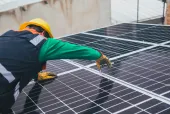
Asia Pacific to eat up almost 41% of global solar capacity additions
Thanks to significant would-be growths in China, India, and Japan.
BMI Research expects the US to drive global solar power capacity additions between 2016 and 2026, installing more than 88GW (including grid-connected rooftop solar power systems).
In comparison, analysts expect the second largest market in terms of additions, China, to add 67GW. "We attribute the US outperformance to our expectation that Investment Tax Credits (ITCs) will not be repealed under Donald Trump's Presidency, as they enjoy significant support among Republicans and have become an important driver of economic activity in many US states," it said.
Here's more from BMI Research:
As the ITCs are to remain in place up to the early 2020s, we forecast solar capacity growth to average 21.4% between 2016 and 2022. From 2022 to 2026, this rate will decelerate to 5.3% as the ITCs run their course.
As a downside risk to this forecast, we note that while we expect the ITC regulation to remain untouched, the current administration's plans for a reform of the federal tax system could indirectly affect support for solar - as lower tax rates could make tax credits less valuable.
Given the high level of uncertainty surrounding the content and timeline of the US tax reform, we will wait before accounting for this risk in our solar power forecasts.
In terms of regional solar capacity growth hotspots, APAC will outperform significantly. China will be the main growth driver, with robust capacity growth in India and Japan bolstering growth, as the two countries will commission about 50GW and 21GW of solar capacity between 2016 and 2026, respectively.
This will mean that the APAC region will comprise almost 41% of total capacity additions globally. In comparison, Western Europe and Northern America (NAWE) combined will only make up 35% of the total.
We also believe there is scope for China to perform better than we expect should the country register progress in mitigating West-East grid bottlenecks, as this has weighed on the prospect for maintaining strong solar capacity growth rates in inland regions where solar potential is better, but power demand is subdued.













 Advertise
Advertise











